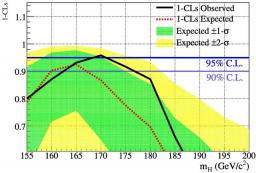Scientists from the CDF and DZero collaborations at the U.S. Department of Energy's Fermilab have combined Tevatron data from the two experiments to advance the quest for the long-sought Higgs boson. They have presented their results on August 3rd at the International Conference on High Energy Physics in
The Standard Model of Particles and Forces--the theoretical framework for particle physics--predicts the existence of a particle, the Higgs boson, that interacts with other particles of matter to give them mass. The mechanism by which particles acquire different mass values is unknown, and finding evidence for the existence of the Higgs boson would address this fundamental mystery of nature.

In this plot the solid black line is above the "95% CL" blue line in a small mass range around 170 Gev/c2. This indicates that the existence of a Higgs boson in this mass range is excluded with a 95% probability.
Combining results from the two collider experiments effectively doubles the data available for analysis by experimenters and allows each experimental group to cross check and confirm the other's results. "These results mean that the Tevatron experiments are very much in the game for finding the Higgs," said Pier Oddone, director of Fermilab. In the near future, the Fermilab experimenters expect to test more and more of the available mass range for the Higgs.
The CDF and DZero experiments each comprise some 600 physicists from universities and laboratories from around the world. CEA Irfu/SPP and CNRS IN2P3 teams play an important role in search for Higgs boson in D0 experiment and then in result combination. Currently, Fermilab’s plans call for the Tevatron experiments to continue operating through 2010. In that time, both groups expect to double their analysis data sets, improving their chances to observe the Higgs.
Scientists expect operations to begin at the Large Hadron Collider at CERN, in
More inforamation : Ursula BASSLER, Marc BESANÇON CEA-Saclay, Irfu/SPP
• The ultimate constituents of matter › Particle physics at colliders
• Institute of Research into the Fundamental Laws of the Universe • The Particle Physics Division
• D0
